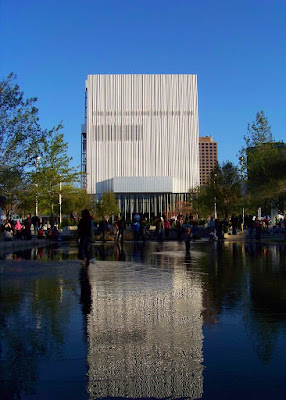
There has been an air of celebration among Dallas civic boosters, local media and even among many of its citizens these past few weeks. The opening of the $350 million AT&T performing arts center marks the culmination of an ambitious vision set forth by city leaders over 30 years ago in the
establishment of the country's largest Arts District. Along a once vacant six-block stretch in downtown just north of the city's gleaming commercial
skyscrapers, the Dallas Arts District features museums and performance halls designed by the world's most renowned architects, four of which are
Pritzker laureates. The two newest additions to the district, the Dee and Charles
Wyly Theatre by Rem
Koolhaas (and his ex-partner Joshua Prince
Ramus) and the Bill and Margot
Winspear Opera House by Foster and Partners, now join the two year old Booker T. Washington School of the Arts by Allied Works Architects, the six-year old
Nasher Sculpture Center by
Renzo Piano, the twenty-year old (and still
sumptuous)
Meyerson Symphony Center by I.M Pei, and finally the Dallas Museum of Art by Edward
Larrabee Barnes that opened in 1984. Add to those a new
SOM-designed city performance hall building under construction and recently unveiled design for the Perot Museum of Nature and Science (yes, that Perot) by Thom Mayne of
Morphosis less than a quarter mile away and you have one of the most elite concentrations of contemporary architecture of any city in the U.S.
While impressive, the city's traditional tendency to enthusiastically embrace big-name architects in the realization of its monumental palaces of culture and business (Pei,
SOM & Philip Johnson) reveals all the more what is still missing in downtown: day to day urban life. Lurking in all the media attention about the opening of the opera house and the theatre was the question, "will the completed Arts District finally bring life to downtown, by attracting people to live there and sustain viable neighborhoods?" Will it lead to the rebirth of downtown, a pedestrian oasis in a
metroplex built on wide spaces and lots of driving?


 There has been an air of celebration among Dallas civic boosters, local media and even among many of its citizens these past few weeks. The opening of the $350 million AT&T performing arts center marks the culmination of an ambitious vision set forth by city leaders over 30 years ago in the
There has been an air of celebration among Dallas civic boosters, local media and even among many of its citizens these past few weeks. The opening of the $350 million AT&T performing arts center marks the culmination of an ambitious vision set forth by city leaders over 30 years ago in the